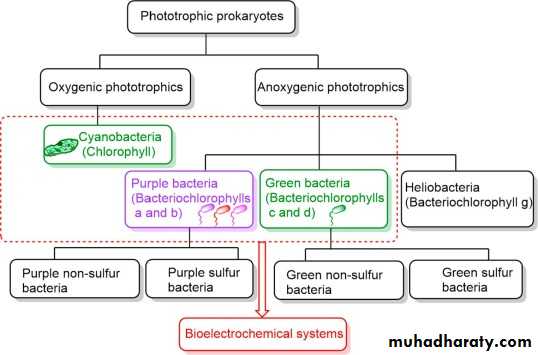Basic bacteriology
D. Faten naeem abbasLecture:
Microbial metabolismMicrobial growth requires the polymerization of biochemical building blocks into proteins, nucleic acids, polysaccharides, and lipids. The building blocks must come preformed in the growth medium or must be synthesized by the growing cells. Additional biosynthetic demands are placed by the requirement for coenzymes that participate in enzymatic catalysis. Biosynthetic polymerization reactions demand the transfer of anhydride bonds from adenosine triphosphate (ATP). Growth demands a source of metabolic energy for the synthesis of anhydride bonds and for the maintenance of transmembrane gradients of ions and metabolites.
The term used to describe all of the chemical reactions inside a cell is metabolism (Fig.). Cellular processes such as the building or breaking down of complex molecules occur through series of stepwise, interconnected chemical reactions called metabolic pathways. Reactions that are spontaneous and release energy are exergonic reactions, whereas endergonic reactions require energy to proceed.
The term anabolism refers to those endergonic metabolic pathways involved in biosynthesis, converting simple molecular building blocks into more complex molecules, and fueled by the use of cellular energy.
Conversely, the term catabolism refers to exergonic pathways that break down complex molecules into simpler ones. Molecular energy stored in the bonds of complex molecules is released in catabolic pathways and harvested in such a way that it can be used to produce high-energy molecules, which are used to drive anabolic pathways. Thus, in terms of energy and molecules, cells are continually balancing catabolism with anabolism.
The strategies used to obtain both carbon and energy can be combined for the classification of organisms according to nutritional type:
Phototrophs (or phototrophic organisms) obtain their energy from sunlight. Phototrophs trap the energy of light using chlorophylls, or in a few cases, bacterial rhodopsin (phototrophic, but not photosynthetic, since they do not fix carbon).
Chemotrophs (or chemosynthetic organisms) obtain their energy from chemical compounds. Chemotrophs that can use organic compounds as energy sources are called chemoorganotrophs. Those that can use inorganic compounds, like sulfur or iron compounds, as energy sources are called chemolithotrophs.
Energy-producing pathways may be either aerobic, using oxygen as the terminal electron acceptor, or anaerobic, using either simple inorganic compounds or organic molecules as the terminal electron acceptor.
Prokaryotes not only can use different sources of energy, but also different sources of carbon compounds:
Autotrophic prokaryotes synthesize organic molecules from carbon dioxide.
Heterotrophic prokaryotes obtain carbon from organic compounds.
A photoautotrophs use energy from sunlight, and carbon from carbon dioxide and water, whereas chemoheterotrophs obtain both energy and carbon from an organic chemical source. Chemolithoautotrophs obtain their energy from inorganic compounds, and they build their complex molecules from carbon dioxide. Finally, prokaryotes that get their energy from light, but their carbon from organic compounds, are photoheterotrophs.
Most organisms are chemoheterotrophs because they use organic molecules as both their electron and carbon sources. Prokaryotes are classified both by the way they obtain energy, and by the carbon source they use to generate the ATP needed for biosynthesis and other cellular activities.
Examples
Carbon Source
Energy Source
Classifications
Hydrogen-, sulfur-, iron-, nitrogen-, and carbon monoxide-oxidizing bacteria
Inorganic
Chemical
Chemoautotrophs
Chemotrophs
All animals, most fungi, protozoa, and bacteriaOrganic compounds
Chemical
Chemoheterotrophs
All plants, algae, cyanobacteria, and green and purple sulfur bacteria
Inorganic
Light
Photoautotrophs
Phototrophs
Green and purple non-sulfur bacteria, heliobacteria
Organic compounds
Light
Photoheterotrophs
• The table below summarizes carbon and energy sources in prokaryotes.
Energy production
There are three major mechanisms for generating of metabolic energy :-Fermentation
• Fermentation the anaerobic breakdown of glucose that results in a gain of 2ATP molecules and end products such as alcohol and lactate
• Fermentation consists of glycolysis (formation of pyruvate) followed by a reduction of pyruvate.
Respiration
• Chemical reaction of an oxidant (electron acceptor) through a specific series of electron carriers in the membrane establishes the proton motive force across the bacterial membrane• The reductant (electron donor) may organic or inorganic substrate e.g. lactic acid serves as a reductant for some organisms, while hydrogen gas is a reductant for other organisms.
• The gasous oxygen is often employed as an oxidant but the alternative oxidant that are employed by some organisms include : CO2 , sulfate and nitrate .
Photosynthesis
Photosynthetic organisms are differentiated from all other forms of life by their ability to derive their cellular energy not from chemical nutrients, but from the energy of the sun. Photosynthesis can be carried out by a number of different microbial species, which can be considered to have two distinct forms:• Oxygenic photosynthesis, in which oxygen is produced; found in algae, cyanobacteria (blue-green algae) and also green plants.
• an oxygenic photosynthesis in which oxygen is not generated; found in the purple and green photosynthetic bacteria.
Both forms of photosynthesis are dependent on a form of the pigment chlorophyll, similar, but not identical, to the chlorophyll found in green plants.





